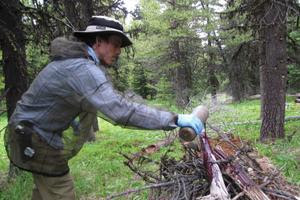Biologists need Cascade grizzly bear DNA sample to prove its existence
 |
| Forest Service technician pours cattle blood and salmon carcass lure to attract bears to the hair snag corral. |
Bigfoots are safe for now because government funded Biologists aren't really looking for them... yet. Instead, they are looking for another elusive creature known as the Cascade Grizzly. CrossCut.com has a story about biologists in Washington and their efforts to prove the creatures' existence in order to persuade the government to provide protection.
Scott Fitkin, a biologist for the Washington Department of Fish and Wildlife has been tracking grizzly bears in the Cascade Mountains for over two decades. Based on sightings and tracks over the years, biologists have estimated that there are fewer than 20 grizzly bears remaining in the North Cascades. Fitkin says he has never seen one in real life. In fact, he had never even seen a photo of one, until this June when photos of a purported grizzly surfaced.
The pictures were taken by a hiker in October 2010 in North Cascade National Park, about 100 miles northeast of Seattle. The photos were encouraging for biologists since it's the first confirmed sighting in the Cascades in 15 years. According to a panel of experts, these are the only known photos of a living grizzly in the range in perhaps half a century.
They showed a silhouetted bear with the distinctive grizzly traits — small ears, dished facial profile, a hump on its back. "It had a grizzly gestalt to it," Fitkin says. A panel of experts confirmed the sighting — the first in the Cascades in 15 years and the only known photos of a living grizzly in the range in perhaps half a century. It reinforced Fitkin's longtime belief: that a few grizzlies still survive in the North Cascades.
Since 1997, the U.S. Fish and Wildlife Service have been trying to push enough support to restore the grizzly population in the Cascades. Unfortunately, their efforts to trigger a restoration have gone unnoticed and only a small amount each year goes towards restoration.
This could all change if biologists can prove that grizzlies actually exists in the Cascades.
Just getting the funding to search for grizzlies is a step. With prompting from the recovery office and $20,000 for this year's survey, the team cobbled together a $100,000 budget with another $60,000 from Fish and Wildlife Region 1 and $20,000 from the Forest Service. Biologists hope for more funding to continue the survey next year. The odds are slim that the piecemeal project might lead to congressional funding for an EIS and future recovery efforts, but DNA proof from a grizzly hair could help.
Biologists are deploying a tactic Bigfoot hunters are quite familiar with. By luring bears with Salmon, they are hoping to snag some hair samples by stretching a coil of barbed wire between trees around a perimeter.
Now Fitkin is back where he started two decades ago, searching for grizzlies, this time in the second summer of the Cascades' most ambitious bear survey yet. Fifteen miles deep in the Pasayten Wilderness in the northeastern corner of the range, he and five colleagues are heading into new territory to set up hair-snag stations. Their aim is to pluck fur from a grizzly somewhere in 9,600 square miles of rugged mountains. DNA from the hair could confirm the presence of grizzlies and indicate how isolated they are from other populations. Last year, 700 hair samples revealed only black bears. But this year, hope runs high.
Once the DNA evidence can prove that grizzlies exists in the Cascades, biologists are hoping to gain more government support and hopefully help restore the population back to a healthy number.
[via crosscut.com]



Okay, maybe it's just me, but I'm kind of hoping they get BF DNA while they're at it.
ReplyDeleteYeah, suuuurrrre.... "cascade grizzly", right....put your tinfoil hats back on, weirdos.
ReplyDelete@autumn I was thinking the same thing..or even just seeing the signs. Now that I have paid close attention to the minutia in the forest specifically associated with BF, it is hard to miss them now....and so perhaps these guys will eventually wonder about that odd stick nest and so forth? Who is funding this? LOL....
ReplyDeleteI've seen the scat...big around as a pop can. Yes they are there.
ReplyDeleteHaving read this I thought it was very informative. I appreciate you
ReplyDeletefinding the time and effort to put this informative article together.
I once again find myself spending way too much time both
reading and posting comments. But so what, it was still worthwhile!
Here is my blog post ... graduate certificate programs online
Hi, I do believe this is a great website. I stumbledupon it ;) I will come back yet
ReplyDeleteagain since i have bookmarked it. Money and freedom is the greatest way to change, may
you be rich and continue to help other people.
Look into my blog post; Raspberry Ketones
You are so cool! I don't suppose I've read something like this before.
ReplyDeleteSo great to discover somebody with genuine thoughts on this
subject. Seriously.. thank you for starting this up. This
web site is something that is required on the web, someone with a bit of originality!
Here is my webpage Home Staging